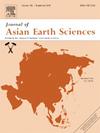Novel insights into the conventional and unconventional hydrocarbon potential of the Sembar Formation, Southern Indus Basin, Pakistan: A multi-analytical and basin modeling approach
IF 2.4
3区 地球科学
Q2 GEOSCIENCES, MULTIDISCIPLINARY
引用次数: 0
Abstract
Significant hydrocarbon discoveries in the Southern Indus Basin of Pakistan are attributed to the Sembar Formation as the primary source rock. Prior studies on the Sembar shale were limited to screening analyses, which were inadequate for accurately evaluating its hydrocarbon potential. Therefore, this study employs a multi-analytical approach to assess organic matter’s impact on hydrocarbon generation by examining its quantity, quality, maturity, sources, and depositional paleoenvironment. The results reveal organic richness ranging from poor/fair to excellent, with total organic carbon varying from 0.51 to 28.12 wt%. The Sembar shale predominantly contains type III kerogen, with occasional type II and type IV presence. The biomarker results indicate a mixture of facies with varying contributions from higher plants, algae, plankton, and bacteria deposited in marine depositional settings that were predominantly suboxic and intermittently anoxic. The Sembar shale has reached the late mature stage, with vitrinite reflectance ranging from 1.11 to 1.40%. Basin modeling indicates a maximum transformation ratio of 72% in Jumman Shah-1 and 60% in Palari Sarki-1 for the Sembar shale. The detailed investigation suggests that the Sembar shale primarily generated conventional gas with a secondary contribution of oil. The abundance of quartz and kaolinite (analyzed through vibrational spectroscopy) in the Sembar shale supports its feasibility for fracturing. In conclusion, this study confirms the shale oil and shale gas potential of the Sembar Formation, demonstrating that integrating a multi-analytical and basin modeling approach provides a novel framework for assessing hydrocarbon potential and identifying sweet spots in the Sembar shale and analogous formations.
巴基斯坦南印度河盆地Sembar组常规和非常规油气潜力的新见解:一种多分析和盆地建模方法
巴基斯坦南印度河盆地的重要油气发现归功于桑巴尔组为主要烃源岩。先前对Sembar页岩的研究仅限于筛选分析,不足以准确评估其油气潜力。因此,本研究从有机质的数量、质量、成熟度、来源、沉积古环境等方面综合评价有机质对生烃的影响。结果表明,有机丰富度从差/一般到优异,总有机碳在0.51 ~ 28.12 wt%之间变化。Sembar页岩以ⅲ型干酪根为主,偶有ⅱ型和ⅳ型干酪根。生物标志物结果表明,在以亚氧和间歇缺氧为主的海洋沉积环境中,沉积的相有不同的贡献,包括高等植物、藻类、浮游生物和细菌。Sembar页岩已进入晚成熟阶段,镜质组反射率为1.11 ~ 1.40%。盆地模拟表明,Jumman Shah-1和Palari Sarki-1的最大转化率分别为72%和60%。详细调查表明,桑巴尔页岩以常规气为主,石油次之。Sembar页岩中石英和高岭石的丰度(通过振动光谱分析)支持其压裂的可行性。综上所述,本研究证实了Sembar组页岩油和页岩气的潜力,表明将多分析和盆地建模方法相结合,为评估Sembar页岩和类似地层的油气潜力和识别甜点提供了一个新的框架。
本文章由计算机程序翻译,如有差异,请以英文原文为准。
求助全文
约1分钟内获得全文
求助全文
来源期刊

Journal of Asian Earth Sciences
地学-地球科学综合
CiteScore
5.90
自引率
10.00%
发文量
324
审稿时长
71 days
期刊介绍:
Journal of Asian Earth Sciences has an open access mirror journal Journal of Asian Earth Sciences: X, sharing the same aims and scope, editorial team, submission system and rigorous peer review.
The Journal of Asian Earth Sciences is an international interdisciplinary journal devoted to all aspects of research related to the solid Earth Sciences of Asia. The Journal publishes high quality, peer-reviewed scientific papers on the regional geology, tectonics, geochemistry and geophysics of Asia. It will be devoted primarily to research papers but short communications relating to new developments of broad interest, reviews and book reviews will also be included. Papers must have international appeal and should present work of more than local significance.
The scope includes deep processes of the Asian continent and its adjacent oceans; seismology and earthquakes; orogeny, magmatism, metamorphism and volcanism; growth, deformation and destruction of the Asian crust; crust-mantle interaction; evolution of life (early life, biostratigraphy, biogeography and mass-extinction); fluids, fluxes and reservoirs of mineral and energy resources; surface processes (weathering, erosion, transport and deposition of sediments) and resulting geomorphology; and the response of the Earth to global climate change as viewed within the Asian continent and surrounding oceans.
 求助内容:
求助内容: 应助结果提醒方式:
应助结果提醒方式:


